This was published 5 years ago
Alcatraz prison island, San Francisco: One of America's strangest national parks
By Alison Cassar
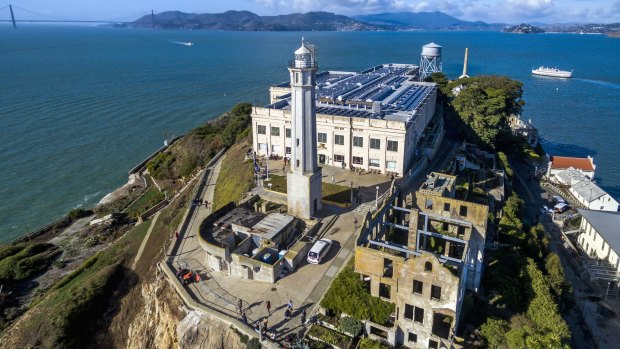
Alcatraz became a federal prison in 1934 - a maximum-security, high-profile penitentiary for men who had proved a problem in other prisons. Credit: Shutterstock
America's national parks are some of the most famous in the world. Think Yellowstone, Yosemite, Grand Canyon and ... Alcatraz.
Wait, what? Alcatraz? Yes this former island prison hellhole is a national park – one of the strangest I have visited, but not uncommon in the US it seems. It is part of a network of less traditional areas that come under the purview of the country's National Parks Service. Also on the list, I learn during my travels, are parts of Arlington National Cemetery and most of the memorials in Washington DC.
And while it may seem an odd inclusion as a national park, it saved Alcatraz from bulldozers in the early 1970s and it has become a haven for wildlife, particularly birds that nest there in their thousands in spring. It is also one of the most popular tourist sites in San Francisco, attracting 1.4 million visitors a year.
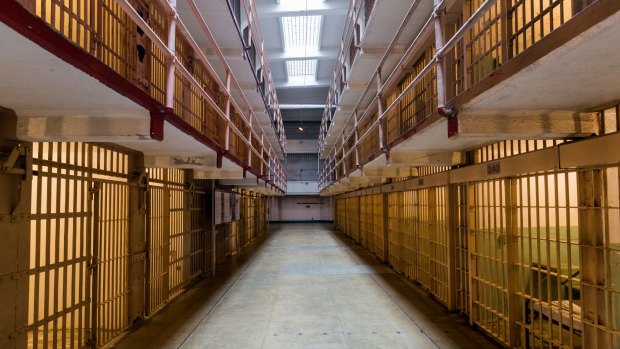
The prison corridors were named after major US streets and landmarks - Broadway, Michigan Avenue, Park Avenue, Sunset Strip Times Square. Credit: Shutterstock
I first see the jail, looming atop the island in San Francisco Bay, from the mainland. You can hear the wind as it moves through the abandoned buildings, sounding like screams. Even on a gorgeous sunny day, the sight and sound sent a shiver up my spine.
Given this, it may seem an odd choice to opt for the night tour, but it was a good decision. This tour takes the longer way to the dock, allowing for better views of the island, including the cave where one would-be escapee hid for three days in freezing water until he realised he wouldn't be able to swim the two kilometres to the mainland and went back to his cell.
And our ferry will be the only one on the island, allowing much freer movement inside and outside the prison.
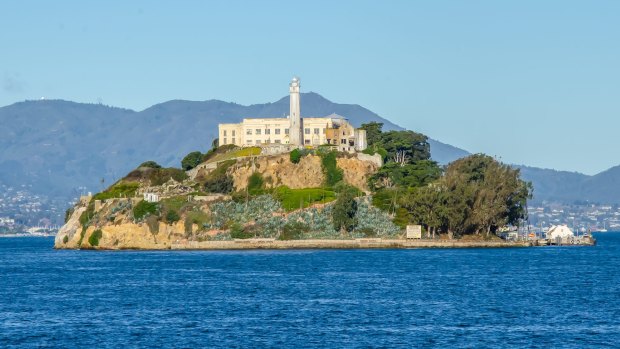
The prison can clearly be seen from San Francisco.Credit: National Park Service
The wind was picking up as our ferry left Pier 33 at 6.30pm. The National Parks staff fill us in on the history of Alcatraz as we chug along.
One of the first buildings erected on the island, which was named by Spanish explorer Juan Manuel de Ayala in 1775, was a lighthouse in the 1840s – it still operates guiding ships into the bay. It was also used as a fortress, forming part of the Union force's defence during the Civil War.
The buildings have almost always operated as a jail – soldiers who committed offences from desertion to murder during the Civil War were kept there as were Native Americans captured during the Indian Wars of the mid to late-19th century.
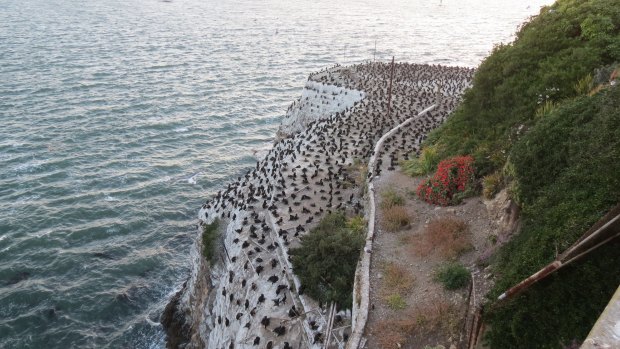
A huge number of birds nest on Alcatraz Island's rocky cliffs.Credit: Spiros Tzioumis
It became a federal prison in 1934 – a maximum-security, high-profile penitentiary for men who had proved a problem in other prisons. It's chilling stories, particularly from this time, have made it ripe for Hollywood treatment and the subject of many books.
As we get closer to the island, staff warn us not to disturb the breeding birds covering the rocks. They also make sure we know the last departure time of the ferry (9.25pm) – if we missed it we may be stuck there with the ghosts.
The first thing that hit us as we docked was the smell of guano. Thousands of nesting cormorants covered the rocky cliffs, their squawks carried to us on the chill wind as the National Parks officer directed us up a hill to the start of our tour.
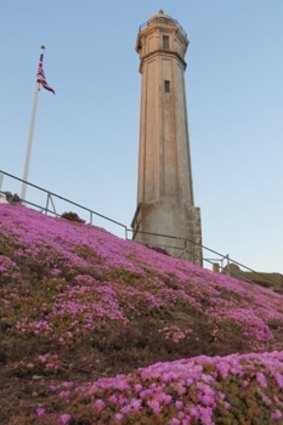
The light house, which is still operational, and garden on the island.Credit: Spiros Tzioumis
I don't normally go for audio tours, preferring to do things at my own pace. But this one has won awards so I decided to opt in and was mighty glad I did.
The 45-minute Cellhouse tour is narrated by a former guard and real inmates' voices are used to recall the conditions, the prisoners' stories and the history of the jail. It makes for an evocative and, at times, poignant narrative such as when an inmate recalls how the famed San Francisco wind would bring the sound of New Year revellers in the city to those locked up inside.
The conditions inside were bleak – cells were tiny, sparse and cold. The corridors dividing the prison blocks were named after major US streets and landmarks – Broadway, Michigan Avenue, Park Avenue, Sunset Strip, Times Square. A cruel touch, I thought, given many prisoners would never see these places.
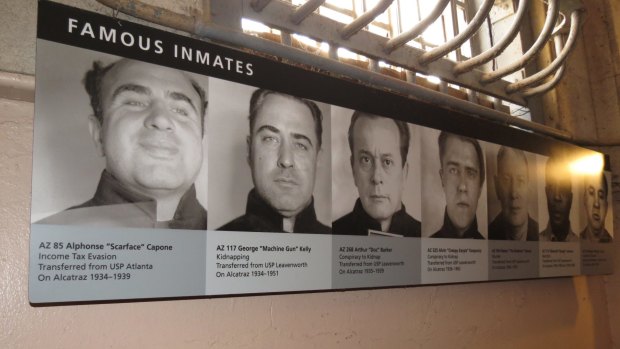
Some of the jail's most famous inmates, including Al Capone (left).Credit: Spiros Tzioumis
Its walls housed criminals from gangster Al Capone (although his cell is not known as he spent much time in solitary confinement) and the Birdman of Alcatraz, Robert Stroud, who was described by a guard on the audio as "intelligent, but a psychopath". Despite his name, Stroud never conducted any of his bird studies at Alcatraz, but at his previous penitentiary, Leavenworth in Kansas.
The jail had four wardens over its 29 years of operation and their families as well as those of the guards lived on the island, the children going to school in San Francisco. Fire destroyed the grand warden's house in 1970, leaving ruins that only added to the eeriness of the site.
Ringed with the icy waters of the bay and with guards stationed at six free-standing towers, escape was virtually impossible. But as I walk through the rows of cells, listening to the stories told by the prisoners, I begin to understand why some of them would attempt to flee.
One of the 14 attempted escapes ended in the Battle of Alcatraz, resulting in the deaths of two officers and three inmates, the audio retelling complete with the sounds of battle and fear transporting the listener into the past.
The best known involved three inmates, Frank Morris and brothers John and Clarence Anglin, who left dummies in their cells to fool the guards (we are taken to their cells complete with replica fake inmates) and slipped into the water using raincoats as flotation devices. The men were never found, and although they are presumed drowned, they are still listed as wanted men. And, of course, their story was made into a movie – Escape from Alcatraz in 1979 starring Clint Eastwood.
Despite the gloomy surroundings, there were moments of levity. The prisoners' food was reportedly excellent, except for one meal – spaghetti. It was on the menu so often and the quality had deteriorated so much that prisoners overturned tables in protest when it was served yet again one dinner time. And while the kitchen seemed a more benign space than others in the jail, the board with silhouettes for various knives and other chopping utensils was frightening in its own way. It was meant to let a guard know immediately if a knife was taken and deter prisoners from taking them. It didn't.
One of the final things you see on the audio tour is a picture of the last prisoner to leave Acatraz in 1963. Attorney-general Robert F. Kennedy closed the prison and the remaining inmates were transferred to other federal jails. The site was occupied by Native American political activists over the years until 1971 – graffiti on the water tower and on the buildings are all that remain of their fight for rights.
The tour ended at Times Square and we had plenty of time to explore the outside of the island, taking in the wildlife, the flowers blooming in the garden (which was tended by the prisoners) and seeing San Francisco lighting up as night fell.
The lighthouse began operating, throwing its guiding beam on to the waters of the bay and we could hear the wind screeching through the jail. I stared up at the buildings, which looked even more forbidding in the rapidly approaching dark and decided to take the second last ferry back to San Francisco.
The trip back on the ferry gave me yet another reason to be glad I took the night tour. The view of the Golden Gate bridge as the sun set was unforgettable as was the city and the Bay Bridge to Oakland lighting up as darkness fell.
It was a sight prisoners may have seen through the bars, but could never reach.
TRIP NOTES
MORE
FLY
Qantas now flies direct from Sydney and Melbourne to San Francisco, while United flies direct from Sydney. Virgin Australia, Delta and American Airlines have connections through Los Angeles, while Air New Zealand flies direct to San Francisco from Auckland.
VISIT
The Alcatraz night tour operates Tuesday to Saturday and costs $US45.50 for adults. See alcatrazcruises.com
The writer travelled at her own expense.
Sign up for the Traveller Deals newsletter
Get exclusive travel deals delivered straight to your inbox. Sign up now.